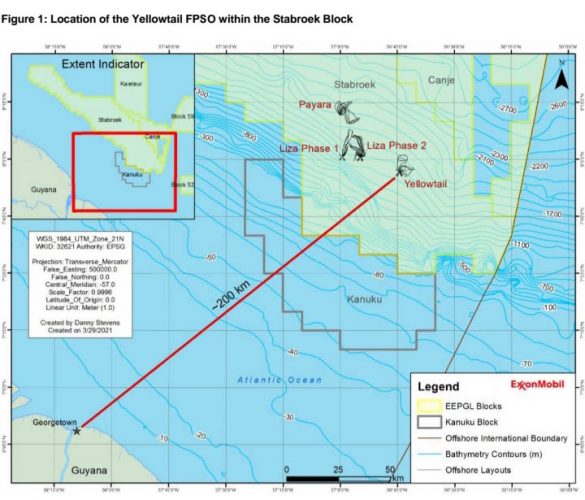The Environmental Protection Agency (EPA) on Friday wrote to ExxonMobil’s consultant Environmental Resource Management (ERM) outlining a list of recommendations to be addressed before a final decision is made on the Yellowtail Development Project’s environmental permit.
Exxon’s local affiliate and partners applied to the EPA for an environmental permit and have since submitted the Environmental Impact Assessment (EIA) and other ancillary documents as part of the process as well as holding public consultations. The statutory period for the public to submit objections expired in December 2021.
During the public consultation phase, a number of environmentalists and groups submitted objections to the EIA, while pointing out that the company failed to address a number of impacts on the environment.
According to the Executive Director of the EPA, Kemraj Parsram, those comments and objections were taken into account in the compiling of issues for ERM to address.
“We have officially communicated to EEPGL’s consultant, which is ERM, our recommendations having reviewed and taking into consideration the public’s inputs [and] independent technical reviews that supported the EPA as well as the EAB [Envi-ronmental Assessment Board],” Parsram said in a brief comment to Sunday Stabroek.
“So, we sent those comments to the consultants as well as the EAB and the consultants will submit a revised EIA, which will be reviewed by the EAB and the EAB then has to give its approval of the EIA. Once I receive the approval or rejection of the EIA, then I’ll take my next course of action,” he added.
The EAB is currently being chaired by Omkar Lochan, who was recently re-appointed to the Board after its life expired in December last year. The other members are Vanessa Benn, Dr Bendita Latchmansingh, Karen Roopchand, Sarah Browne, Desmond Sears, Dr Josh Kanhai and one representative each from the Guyana Geology and Mines Commission and the Forestry Commission.
When asked about what sort of recommendations were provided to ERM, Parsram said that he was not in a position to release those as yet. He also said that a timeline has not been attached for ERM to submit the revised EIA.
“We have not attached a timeframe because there are some things that can be addressed immediately and some would take some time. So, as I said, the EAB will communicate its recommendation after it receives the revised EIA and then we would take it from there,” he said.
The Yellowtail project is ExxonMobil’s and its partners’ fourth development in the Stabroek Block and is considered the largest undertaking since Guyana became an oil-producing nation. As part of the Yellowtail Project, ExxonMobil plans to drill between 40 and 67 wells for the 20-year duration of the investment. It is intended to be the largest of the four developments with over 250,000 barrels of oil per day targeted once production commences. Based on the schedule, once approval is granted, engineering commences this year and production in the latter part of 2025.
Exxon’s last development was Payara, which is expected to come on stream next year. Payara is the third petroleum development project in the Stabroek Block that has been granted the go-ahead. It entails the drilling is some 45 injection and production wells and is expected to produce between 180,000 and 220,000 barrels of oil per day.
The final EIA for the Payara project was submitted in July 2019 and approval was granted for the environmental permit on September 18, 2020. The permit was issued on September 24, 2020.
Government recently announced that United Kingdom-headquartered oil and gas consultancy, Bayphase Ltd was contracted to conduct the review of the Yellowtail Development Plan. Bayphase also conducted the review of Liza and Payara projects in the Stabroek Block.
They will be paid US$423,360 for the execution of the contract.
During a recent press conference, Vice President Bharrat Jagdeo, while providing an update on the sector, had said there were some setbacks in the review process for Yellowtail. He explained that the government is anticipating a completion of the process by the end of March.
Environmentalists and other activists have been calling for the EPA to deny Exxon’s application until a new EIA can be conducted to address the serious environmental implications the project is expected to have.
‘Sufficiently deficient’
American deep-sea scientist, Dr Erik Cordes, in a letter to the EAB, had said that the EIA is seriously deficient and does not paint the correct picture of the impact of its offshore activities. He noted that with most offshore projects, like Exxon’s, at the depth of more than 1,000 metres the EIA was missing critical pieces of information that are required to make informed decisions relating to the potential impacts of the Yellowtail project.
With the seeming rush to have the project approved, Dr Cordes highlighted that ERM failed to provide substantial data about the distribution of potentially sensitive species for particularly benthic organisms in the area. Benthic organisms refer to organisms living on or near the seabed.
During the final public consultation in November last year, a number of environmentalists and activists railed ERM for its failure to treat certain aspects of the environmental impact of offshore activities. For instance, Jamaican environmentalist Diana McCaulay had called for the EPA to hold off on approving the project until it shares the EIA findings with other territories. Her Trinidadian counterpart, Gary Aboud, of the Fishermen and Friends of the Sea (FFOS), threatened legal action against Guyana if it fails to address certain aspects of the findings of the EIA.
A number of environmentalists and groups submitted objections to the EIA, noting that the company failed to address a number of impacts on the environment. Also, questions were raised about ERM’s ties to Exxon since it is the same company that did all of Exxon’s EIAs. There were also calls for the scrapping of the EIA.
In a December 15, 2021 letter to EAB Chairman Lochan, environmentalist Simone Mangal-Joly, on behalf of the Caribbean Coastal Area Management (C-CAM) Foundation, The Jamaica Fish Sanctuary Network, the Jamaica Environment Trust, the Institute for Small Islands, Fishermen and Friends of the Sea, and Freedom Imaginaries, also says that the EIA is “significantly deficient” as it fails to establish a baseline economic value of the coastal areas of the Caribbean, including Guyana.
“We, therefore, call on the EPA [Environmental Protection Agency] to reject the EIA until minimum guarantees are established in Guyana,” Mangal-Joly added in the letter.






